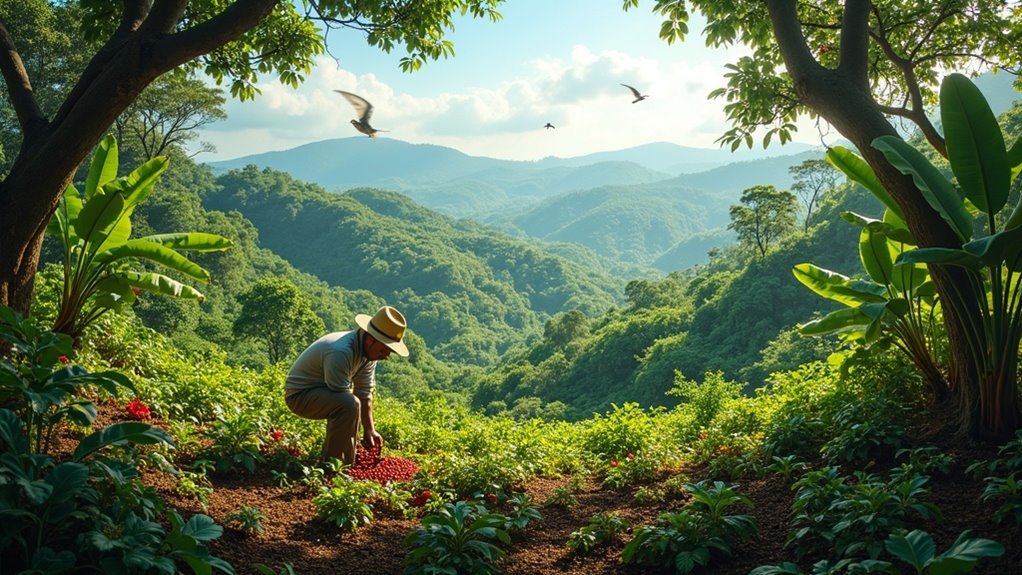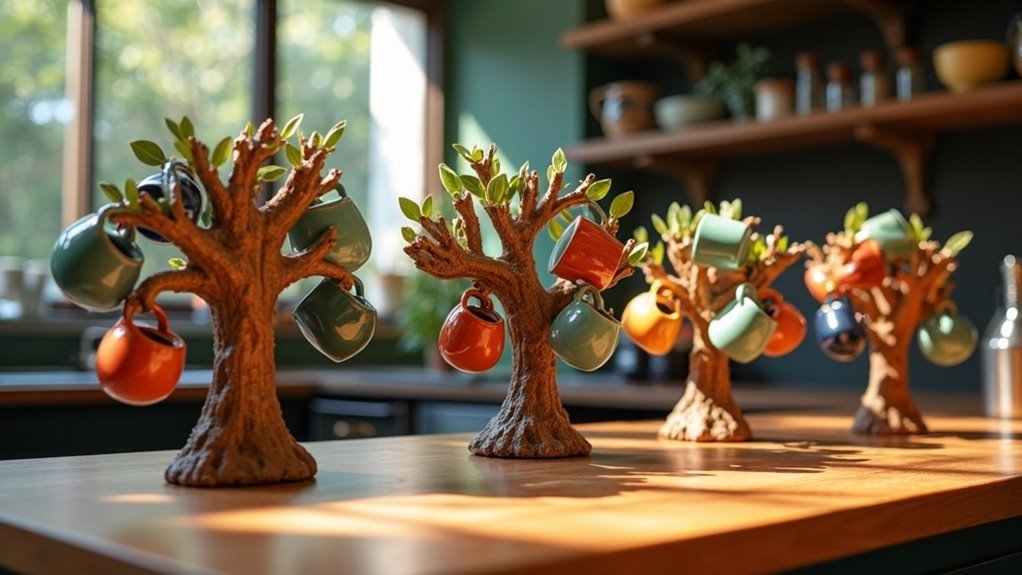Polyculture coffee farming integrates coffee cultivation with a variety of crops and trees, enhancing biodiversity and improving ecosystem health. By growing coffee in the shade of taller trees, your coffee farm benefits from enhanced soil quality and reduced erosion. This system promotes natural pest control and can yield coffee with more complex flavors. While it may appear less labor-efficient, the long-term economic and environmental benefits make it an appealing choice for coffee growers. Explore further to uncover more advantages of this sustainable coffee farming practice.
Key Takeaways
- Polyculture coffee farming integrates coffee cultivation with various crops and trees, enhancing biodiversity and ecosystem health, which benefits coffee quality.
- This sustainable practice involves growing coffee in the shade of taller trees, improving soil quality and reducing erosion, crucial for maintaining healthy coffee plants.
- It promotes diverse income sources through additional crops, increasing overall revenue and profit margins for coffee farmers while allowing them to expand their offerings.
- Polyculture coffee results in more complex flavor profiles due to the variety of plants and growing conditions, making the coffee more unique and appealing to consumers.
- The system reduces reliance on chemical pesticides by fostering natural pest control and supporting healthier ecosystems, which is essential for producing high-quality coffee.
Definition of Polyculture Coffee Farming
Polyculture coffee farming is a sustainable agricultural practice that integrates coffee plants with a variety of other crops and trees, creating a biodiverse ecosystem.
This method enhances biodiversity by fostering a natural environment that supports multiple plant and animal species, which aids in pest control and improves pollination. Coffee is typically grown in the shade of taller trees, promoting better soil quality and reducing erosion.
Although polyculture may be less labor-efficient than monoculture, it offers economic benefits through diverse crop yields and additional income streams, while also increasing resilience against pests and diseases in the long run.
This approach not only contributes to the quality of coffee produced but also supports a healthier planet and local economies.
Benefits of Polyculture Coffee Farming
The advantages of polyculture coffee farming are substantial and diverse, contributing significantly to both agricultural sustainability and the economic viability of coffee farmers. By fostering biodiversity, this approach not only supports local ecosystems but also creates habitats for essential pollinators and natural pest predators. The presence of varied root systems leads to improved soil health, which reduces erosion and enhances nutrient cycling. Additionally, farmers have the opportunity to diversify their income by cultivating complementary crops such as black pepper and citrus fruits alongside their coffee plants. Shade-grown coffee, in particular, often boasts a richer flavor profile due to the slower ripening process. Furthermore, the diversity of plants reduces pest pressure, which in turn decreases the reliance on chemical pesticides, thereby promoting organic coffee production.
| Benefit | Description | Impact on Farming |
|---|---|---|
| Biodiversity | Multiple species coexist, enhancing ecosystems | Supports ecosystems |
| Soil Health | Diverse root systems improve nutrient cycling | Reduces erosion |
| Income Diversification | Additional crops boost overall revenue | Higher profit margins |
| Flavor Complexity | Shade-grown coffee develops a more complex flavor | Enhances taste |
| Pest Pressure | Lower pest levels due to a diverse plant environment | Reduces pesticide use |
Types of Polyculture Systems in Coffee Farming
While exploring the various types of polyculture systems in coffee farming, you’ll discover that each method offers unique advantages tailored to enhancing sustainability and productivity in coffee cultivation.
Consider these systems:
- Cover Cropping: Planting non-commercial crops alongside coffee improves soil quality and moisture retention, vital for healthy coffee plants.
- Companion Planting: Strategically placing nitrogen-fixing legumes with coffee maximizes nutrient availability, promoting robust growth and better yields.
- Intercropping: Growing multiple crops together with coffee fosters biodiversity and resource efficiency, creating a resilient farming ecosystem.
- Agroforestry: Integrating coffee with trees not only enhances ecological benefits but also provides additional income sources, creating a diversified farming strategy.
These approaches not only support healthy coffee production but also promote balanced ecosystems, demonstrating the effectiveness of polyculture coffee farming.
Economic Considerations for Polyculture Coffee Farmers
Implementing polyculture systems in coffee farming not only enhances ecological health but also opens up significant economic opportunities for farmers.
By cultivating diverse produce like black pepper and oranges alongside shade-grown coffee, farmers can increase overall revenue from their coffee operations. Specialty markets often pay premium prices for high-quality, environmentally friendly coffee products.
While managing shade trees may raise initial costs, coffee farmers can benefit from reduced expenses on fertilizers and pesticides due to natural ecosystem services. This resilience in farm management supports stable income over time for coffee growers.
Economic incentives are vital, especially for smallholder coffee farmers, as initial returns may be lower compared to traditional monoculture coffee practices.
Environmental Impact of Polyculture Coffee Farming
Polyculture coffee farming greatly impacts the environment by fostering biodiversity and enhancing ecosystem health. By integrating diverse crops, these systems create healthier habitats and promote resilience.
Polyculture coffee farming enriches ecosystems, boosts biodiversity, and creates resilient habitats through diverse crop integration.
- Supports 90 to 120 native plant species, boosting biodiversity crucial for coffee ecosystems.
- Provides shade for 184 bird species, including 46 migratory birds, which help in pollination and pest control.
- Reduces soil erosion and enhances soil health through structural complexity, benefiting coffee plant growth.
- Minimizes reliance on chemical fertilizers and promotes natural pest control, leading to healthier coffee crops.
This approach not only nurtures the ecosystem but also mitigates the negative effects on coffee farms, making polyculture coffee farming a more sustainable agricultural practice overall.








